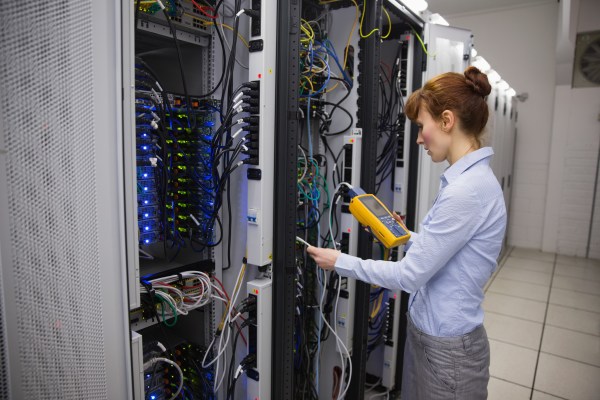Data centers are arguably the engines of modern businesses. Understanding the complexities of those engines is the job of skilled IT personnel. Most people can, however, gain a general understanding of them and would benefit from doing so. With that in mind, here is a quick guide to what you need to know about data center functionality.
Servers: the backbone of data centers
Servers are the backbone of data centers, handling data processing, storage, and distribution for applications and users. They ensure timely service delivery by responding to requests and managing resources efficiently.
Technologies powering modern server systems: Modern servers utilize advanced technologies like multi-core processors, solid-state drives (SSDs), and virtualization software. These technologies enhance performance, scalability, and resource utilization, enabling servers to handle diverse workloads effectively.
Scalability options for server infrastructure: Server scalability involves vertical scaling, adding resources to existing servers, or horizontal scaling, adding more servers to the network. Virtualization and cloud computing further enhance scalability by dynamically allocating resources based on demand, ensuring data centers can adapt to changing workloads.
Maintenance requirements to ensure server reliability: Regular maintenance tasks, including system monitoring, software updates, and hardware diagnostics, ensure server reliability and prevent downtime. Backup, redundancy, and disaster recovery plans mitigate the impact of potential failures, enhancing overall reliability.
Best practices for optimizing server performance and efficiency: Load balancing, resource consolidation, and efficient cooling and power management are key practices for optimizing server performance. Automation and orchestration tools streamline administrative tasks, enhancing server management efficiency and reducing operational costs.
Storage systems: safeguarding data assets
Storage systems are integral to data management, ensuring the secure storage and management of vast amounts of data. They guarantee data availability, reliability, and integrity, forming a critical component of IT infrastructure.
Overview of storage technologies: Storage technologies include traditional hard disk drives (HDDs), solid-state drives (SSDs), and emerging technologies like NVMe and storage-class memory (SCM). Each technology offers unique benefits in terms of performance, capacity, and cost.
Scalability options for storage solutions: Storage solutions scale vertically or horizontally, with cloud-based services providing flexible scalability. This allows organizations to accommodate growing data volumes dynamically.
Maintenance considerations for storage systems: Maintenance involves monitoring performance, applying updates, and implementing backup and disaster recovery. Regular data integrity checks and capacity planning ensure optimal system performance and reliability.
Best practices for data storage management and security: Practices such as data encryption, access controls, and backup strategies protect against unauthorized access and data loss. Storage tiering and deduplication optimize utilization and reduce costs, while compliance standards ensure regulatory adherence and data protection.
Networking devices: enabling communication
Networking devices facilitate communication between servers, storage systems, and other devices within the data center. They establish and maintain connections, ensuring seamless data transfer and access across the network infrastructure.
Technologies driving data center networking: Key networking devices include switches, routers, firewalls, and load balancers, each serving specific roles in data center connectivity. Advanced technologies like Software-Defined Networking (SDN) and Network Function Virtualization (NFV) enhance flexibility, scalability, and automation in data center networking.
Scalability options for networking infrastructure: Networking infrastructure can scale vertically by upgrading individual components or horizontally by adding more devices. Virtualization technologies enable dynamic resource allocation, supporting rapid scaling to accommodate changing demands.
Maintenance requirements for ensuring network reliability: Regular maintenance involves monitoring network performance, applying firmware updates, and configuring security settings. Redundancy and failover mechanisms mitigate the risk of network downtime, ensuring high availability and reliability.
Best practices for designing and managing data center networks: Designing resilient network architectures, implementing segmentation and access controls, and prioritizing traffic management are essential for optimizing data center network performance and security. Automation tools streamline network management tasks, improving efficiency and reducing human errors.
Cooling infrastructure: beating the heat
Cooling systems are vital for maintaining optimal temperatures within data centers to prevent equipment overheating and ensure reliable operation. They dissipate heat generated by servers, storage systems, and networking equipment, safeguarding against performance degradation and hardware failures.
Overview of cooling technologies: Cooling technologies encompass air cooling, liquid cooling, and hybrid systems, each offering unique advantages in efficiency, scalability, and environmental impact. Advanced techniques like containment systems and precision cooling further optimize cooling efficiency and distribution.
Scalability options for cooling infrastructure: Cooling infrastructure can scale alongside increasing heat loads by adding additional cooling units or upgrading existing systems. Modular cooling solutions allow for flexible expansion while minimizing downtime and operational disruptions.
Maintenance considerations for cooling systems: Regular maintenance involves cleaning air filters, inspecting cooling components, and monitoring temperature and humidity levels. Preventive maintenance and predictive analytics help identify potential issues before they escalate, ensuring uninterrupted cooling performance.
Best practices for optimizing cooling efficiency and reducing energy consumption: Utilizing airflow management strategies improves cooling efficiency and reduces energy consumption. Implementing variable-speed fans and energy-efficient cooling units further enhances efficiency while minimizing operational costs.






